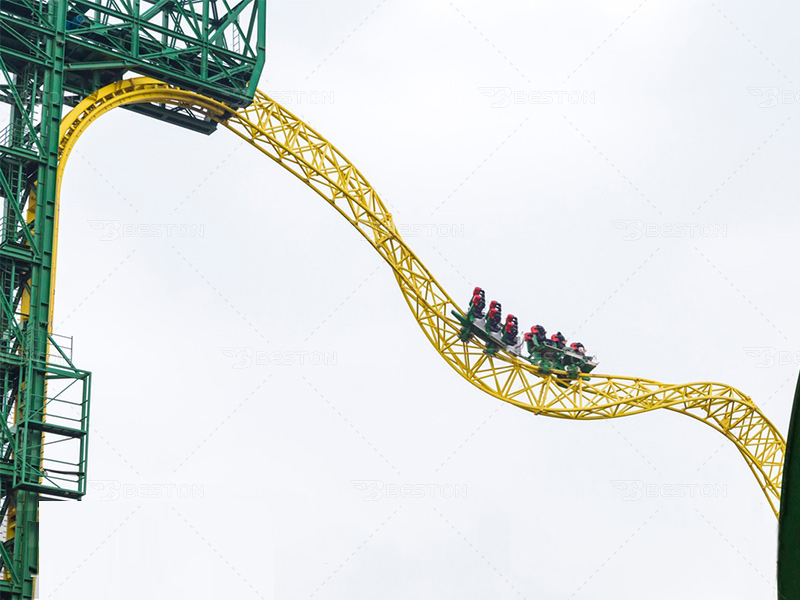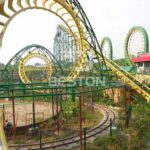A roller coaster is an amusement park ride that consists of a track with steep slopes and curves designed to give passengers an exciting and thrilling experience. Riders typically sit in cars or trains that are propelled along the track at high speeds, experiencing various sensations such as drops, twists, turns, and sometimes inversions (where the riders go upside down). Roller coasters can vary greatly in design, size, and intensity, offering a wide range of experiences for thrill-seekers of all ages.

How Does Roller Coaster Rides Work?
Roller coaster rides work based on principles of physics, mechanics, and engineering. Here’s a basic breakdown of how they operate:

- Potential and Kinetic Energy: The thrilling properties of a roller coaster rely on the interaction between potential energy (energy stored due to height) and kinetic energy (energy of motion). When the ride begins, the coaster is lifted to a high point, creating potential energy. As it descends, this potential energy is converted into kinetic energy, causing the roller coaster to accelerate giving a thrilling experience.
- Initial Climb: A roller coaster usually begins with a chain lift or launch mechanism that carries the coaster to a high point, usually the highest point on the ride. This requires an external energy source, such as electrical or hydraulic power. Different types of roller coasters have different operating methods, and you can choose according to your budget and needs.
- Gravity and Inertia: Once the coaster reaches the first hill, gravity takes over. Gravity pulls the coaster toward the track, converting potential energy into kinetic energy. A roller coaster gains speed as it descends due to gravity, and its inertia moves it forward.
- Friction and Braking: Friction between the coaster wheels and the track, as well as air resistance, help control the speed of the coaster and prevent it from going too fast. Use magnetic brakes or friction brakes to gradually slow down and safely stop the coaster at the end of the ride.
Know About Common Types of Roller Coaster
Here are some of the common types of roller coasters, each offering its own blend of excitement, innovation, and engineering prowess. We understand the relevant big roller coaster types and can help you make a better choice when purchasing a roller coaster. Contact us for roller coaster price list!
Giant Roller Coaster

- Wooden Roller Coasters: These wooden roller coasters have a classic retro feel and are primarily made of wood. They often feature traditional designs and layouts, including hills, drops, and curves. The wooden roller coaster is shaky, which adds to the excitement.
- Steel Roller Coasters: Steel coasters are known for their smoothness and flexibility in design. Steel roller coaster can feature inversions, twists, corkscrews, and other dynamic elements not feasible with wooden coasters.
- Hyper Coasters: Hyper coasters are characterized by extreme height and speed, often reaching heights of 200 feet (61 meters) or more. They offer thrilling drops and airtime.
- Dive Coasters: Dive coasters feature vertical drops of 90 degrees or more, giving riders the sensation of freefall before entering other elements of the ride.
- Launched Coasters: In its original form, the Launch Coaster does not use a traditional chain lift. In contrast, a powerful launch mechanism is used to propel passengers forward at high speeds.
- Terrain Coasters: These coasters are built to take advantage of natural terrain features such as hills, valleys, and forests. They often feature twists and turns that follow the natural contours of the landscape, providing a unique and scenic ride experience.

magic loop roller coaster ride for sale - Family roller coasters: Family roller coasters are generally suitable for children and families to play together. Family roller coasters have lower height restrictions and gentler elements. They are also exciting and more suitable for small and medium-sized playgrounds.
- Shuttle Coaster: A shuttle coaster travels forward and backward along the track, usually with vertical or near-vertical spikes where the train can reverse direction. If you have related purchasing needs, please contact Beston Rides – a professional small roller coaster manufacturer and designer.
- Spinning Coasters: A spinning roller coaster features cars spinning freely on a track. This means that while you are following the track, you are also spinning yourself. This adds an element of unpredictability to the ride experience. This spinning coaster gives people two different experiences at the same time, giving people a unique feeling.
Small Roller Coaster
- Family roller coasters: Family roller coasters are generally suitable for children and families to play together. These are designed with accessibility in mind. Family roller coasters have lower height restrictions and gentler elements. They are also exciting and more suitable for small and medium-sized playgrounds.
- Shuttle Coaster: A shuttle coaster travels forward and backward along the track, usually with vertical or near-vertical spikes where the train can reverse direction. If you have related purchasing needs, please contact Beston Rides – a professional roller coaster manufacturer and designer.

Beston Rides Roller Coaster Manufacturer and Supplier
Beston Rides is a well-known manufacturer and supplier of amusement rides, including roller coasters. We are based in China. Moreover, we offer a wide range of roller coaster models to amusement parks and entertainment venues worldwide. If you’re in the market for a roller coaster for your amusement park or venue, choose Beston Rides! Beston Rides is a reputable manufacturer and supplier worth considering.











